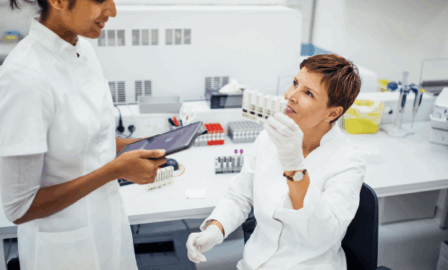LIS vs. LIMS: What’s the Difference?
Laboratory Information Systems (LIS) and Laboratory Information Management Systems (LIMS) serve important purposes in laboratories. The foundational difference between LIS and LIMS is primarily the laboratory setting of the system. With LIS, the system is centered around a patient in the clinical setting. With LIMS, the system is centered around production batch or lot testing in a quality setting. The focal point of each system contributes to the vendor selection, sample workflow decisions, and required features.
While they have very similar names and share many features, each system has unique characteristics to aid in ensuring accurate and quality results in the laboratories they serve. Below, we break down LIS vs. LIMS, exploring both their differences and similarities, to help guide your decision-making when deciding on what technology to implement in your lab space.
Industries
Looking at the different centricities of the systems, it is important to understand the industries they serve. LIS is most suitable for a laboratory that completes testing on patient samples – for example, hospital systems, physician offices, specialty diagnostic labs, pathology, public health, fertility/IVF, and veterinary. In these types of laboratories, easy access to historical results and results from reference laboratories, or other physician offices, are vital to the continuum of patient care. Requirements and guidelines for LIS assure both quality of laboratory results as well as timely reporting to keep effective patient care at the forefront.
LIMS is typically found in laboratories of various industries that focus on quality testing, such as pharmaceutical, biotech, food and beverage, oil and gas, cannabis, research and development, and personal care. In these laboratories, testing is usually performed on materials through the manufacturing process, such as raw materials, in-process materials, and finished goods. Stability, or shelf-life, experiments are also often documented in the LIMS to validate the potency, safety, and efficacy of a material over time.
Accrediting Agencies and Compliance
Accreditation and compliance are essential to clinical and quality laboratories but differ in the specific agencies that issue guidelines and accreditations. Where LIS is typically used, clinical laboratories follow guidelines called the Clinical Laboratory Improvement Amendments (CLIA), issued by the Centers for Medicare and Medicaid Services (CMS). These regulations are enforced by approved accreditation agencies, two of the more common being the College of American Pathologists (CAP) and The Joint Commission.
As with any organization that handles clinical information, Health Insurance Portability and Accountability Act (HIPAA) compliance is also required for LIS to safeguard patient Protected Health Information (PHI). The International Organization for Standardization (ISO) has a set of standards issued that apply specifically to medical laboratories, ISO 15189, which ensures the quality of services, recognizes competence in a medical laboratory, and provides guidance on the structure of the laboratory. Lastly, the Food and Drug Administration (FDA) has oversight in limited areas of clinical laboratories, such as test complexity categorization and blood bank practices, with expansion to include laboratory developed tests (LDTs) beginning in 2025.
Alternatively, where LIMS is typically used, quality laboratories are accredited by the FDA and follow the Code of Federal Regulation (CFR) Title 21 that contains codified Federal laws and regulations that are in effect as of the date of the publication pertaining to food and drugs. A key part of this regulation that directly applies to LIMS is 21 CFR Part 11, which specifically speaks to electronic records and electronic signatures. Many quality laboratories operate to ensure that ISO standards are met, specifically ISO 17025, which provides international requirements for testing and calibration. This not only demonstrates competency and consistency in operations of the laboratory, but also ensures results are accurate and reliable.
Similarities
Although LIS and LIMS are usually seen in different types of laboratories, both systems aid organizations in producing accurate and precise testing results. Because of this common mission, there are several similarities between LIS and LIMS.
- Instrument and System Interfacing: Both systems can interface with instruments and other systems to increase efficiency and decrease errors. Interfacing with instruments is vital due to the large amounts of data produced during testing in any laboratory. With system interfacing, for example, a LIMS can interface with an Enterprise Resourcing Planning (ERP) system like SAP so that lot or batch information can seamlessly flow bidirectionally. A LIS can interface with an Electronic Health Record (EHR) so that results can be accessed by the care team within moments of being finalized and released.
- Audit Trails: LIS and LIMS both utilize detailed audit trails to track key information. Examples of information that would be recorded on an audit trail include the date, time, and identification of the person that performed an action on a sample. Types of activities captured may include changes made to a result after it has been reported, location of a sample, the source of the data entry (manual entry or interfaced entry), and critical result documentation.
- Data Analysis: With the amount of data that is housed in LIS and LIMS, it is no surprise that analysis of the data would be a valuable feature of the system. Result trending and quality control data monitoring help identify issues early. Reports like Certificate of Analysis (COA) and test panel reports for patient results provide a clear and concise record of the testing results. Other important applications of data analysis in these systems include in and out of specification flagging, turn-around-time statistics, and test counts for staffing or reagent estimating.
- Inclusion in Inspections: Both LIS and LIMS must be properly and thoroughly validated. Documentation of validation activities and standard operating procedures (SOP) for the system are included in the inspection process.
LIS vs. LIMS: Making an Informed Decision
It’s important to know the similarities and differences between a LIS and LIMS so that an informed decision can be made when evaluating the type of system to implement in your laboratory.
Clarkston Consulting has extensive laboratory informatics experience to help guide your team through any challenges that may be encountered with your laboratory system.



